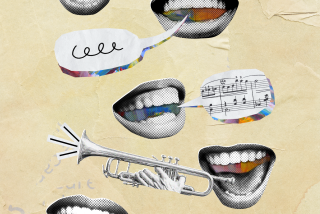Say What? : Herewith the true confessions of a persistent--if only moderately successful--student of Spanish: Most attempts to get the language of Spain in her brain have gone down the drain.
- Share via
The man on the audio cassette is yammering, “The light is loose. The light is loose.” So what? I think. “Listener, do you know how we say ‘light’ in Spanish?” he asks, in the patient tone of Mr. Rogers. “Loose.”
“Oh, luz ,” I note mentally. I wonder if he has a mnemonic device for every word in the language. “The arm of Mario is in the cupboard,” he continues. “Listener, how do we say, ‘cupboard’? Armario. “
Perhaps it would be easier to learn the hard way.
I’m listening to Speed Spanish I--a set of eight audio cassette tapes (from National Dynamics $179.95) and the ninth or 10th “revolutionary” language instruction system that I’ve tried to help me hablar espanol.
A few years ago, after a frustrating vacation in the Yucatan during which I was totally dependent on my multilingual husband, Duke, to make sure the agua was purificada o hervida (boiled), I vowed that I would bridge the language gap. After all, I live in an area where, according to the 1990 census, about 1.5 of 8.9 million people speak primarily Spanish. I also travel to Latin American countries a couple of times a year. And I hate not being able to communicate.
I’m not alone, judging from the staggering array of classes (UCLA Extension alone offers 60), tapes, videos, language schools, workbooks, flash cards, games, “Gardener Spanish” memo pads, and computer software available today.
“You can learn out of a phone book if you really want to,” said Robert B. Kaplan, a professor of applied linguistics at USC, who cites three basic variables to language study. Motivation is the most important. “The best place to learn is the bedroom. When you fall in love the motivation is very high.”
I’m not surprised. A few months ago, I took a sample private lesson from a muy guapo (very handsome) tutor from Madrid. Suddenly questions like Que quieres? (What do you want?) and Donde vives? (Where do you live?) seemed fraught with intriguing possibilities.
I calculated the positive effect on my vocabulary versus the deterioration of my marriage and decided to try another way.
Kaplan warned me that the second variable is natural ability. “If you have no aptitude for language-learning, you’re not going to do very well,” he said. Frankly, I’m not gifted. Somewhere in the back of my mind is a locked trunk stuffed with six years of French, a language I found completely unrewarding. Not only didn’t I need it at the car wash, when I traveled abroad my every utterance was greeted with a sneer.
“The third variable is attitude,” Kaplan said, explaining, “ ‘If I don’t like you, I won’t learn your language.’ ”
For the language of Cervantes, I was willing to try anything. My strangest effort was “Spanish for Travelers,” a three-cassette course by Superlearning Inc. ($39.95), which is based on Bulgarian learning experiments. Researchers discovered that total relaxation dramatically increases learning ability, so I was instructed to take off my shoes and breathe in time to Baroque music designed to harmonize my body/mind rhythms. Next, I took a ride on an imaginary silver escalator to my main inner level, where learning is joyous. By the time I got to the survival phrases like Como esta usted? I was half asleep.
I decided to try another way. I learned how to meditate. My inner guide directed me to buy another tape course called Pimsleur Speak and Read Essential Spanish I ($250). The brochure promised that if I completed 30 lessons--a half-hour a day--in four to six weeks, I’d be able to pass the Foreign Service Level One Exam (not that they were actually giving this test).
I would have bet that I’d collect the money-back guarantee until I played Lesson One and discovered that the first thing I learned to say was Perdon senor. No entiendo. (Excuse me, Sir. I don’t understand). This struck me as sublimely sensible and I was hooked.
Shortly after I finished the last tape, Duke and I went to Ecuador and I was able to understandably order meals, complain that there was no hot water, and ask the price of blusas and joyeria. I couldn’t bargain well, but I can’t do that in English either. As for conversations, I could start them but almost any unexpected response left me speechless.
As soon as we returned home I ordered Pimsleur’s Speak and Read Essential Spanish II. David, my customer service representative, assured me that after another 30 lessons I’d be “rocking and rolling,” but this wasn’t the case. I acquired a dozen verbs, an improved accent, a shaky grasp of the past tense and an acute awareness of how much more I needed to know. I called for Level Three. “It’s in development,” David said. “It won’t be out for another year.”
“What am I supposed to do?” I asked.
“Italian,” he replied.
I bought grammar wheels. I bought workbooks. I even tried the granddaddy of language schools, Berlitz, founded in 1878 by Maximilian Berlitz. The director refused to discuss price over the phone: I had to come in, fill out an application and be assessed.
After a cursory conversation she concluded that it would be best if I bought a series of 30 private lessons, which cost $1,200. When I was able to breathe again, I discovered that what I would actually get were 10 “sessions” consisting of three 45-minute lessons, and this didn’t include registration ($50), or books and tapes ($135). I figured it would be cheaper to spend a couple months at the Acapulco Princess where I’d never have to speak a word of Spanish, so I passed.
(But last October my friend Deborah answered an ad that promised she’d “Speak Spanish by Christmas.” Note, it didn’t specify which Christmas. “All I learned was how to say Berlitz with anger,” she reported later, though she concedes that she’s tone deaf.)
Eventually, I sprang for considerably cheaper private lessons at a language school named after a familiar French children’s song. The director gave me an impressive sample class, the likes of which I never got again. I was, however, given extensive instruction on school policy regarding the cancellation of class 24 hours in advance. The two native-speaking tutors I had were adequate if less than inspiring, and I obviously learned something because the next time Duke and I went to Mexico I was far more adroit.
For instance, a vendedora in Guadalajara approached us in a farmacia.
“Tiene dolor?” she asked. (Have you pain?)
“Todavia, no,” I replied. (Not yet.)
She laughed, which was gratifying. I estimated my little joke cost me $85. Duke must have been impressed, though, because soon afterward he began taking Cantonese, a language even he calls insanely difficult, and now he’s talking about vacationing in South China. But I was content. I knew enough Spanish to do what I wanted and I didn’t feel the urge to learn more.
So you may be wondering why I’m listening to Speed Spanish, instead of Cantonese. To tell the truth, I couldn’t resist the radio commercial. It’s the one that begins, “S-O-C-K-S.” The operator promised that I’d be speaking the language in 30 days, conversational in 60, and fully fluent in 90 to 120 days or my money back. “A 4-year-old can do it,” he said.
Anyone who has ever been on a ski slope knows better than to underestimate a toddler, but I thought it might be the magic formula I’ve been searching for all these years.
“There is no magic formula,” said USC professor Kaplan. “If you really want to be fluent it’s going to take 10 years.”
Hasta la vista, baby.


